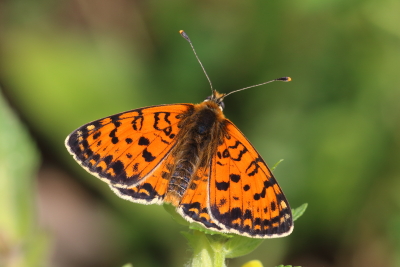

















Spotted Fritillary (Melitaea didyma)
2024 photographs highlighted in yellow. Click on any photograph to go to an enlarged picture, or simply scroll down the page.
|
A very common, especially in the south, and extremely variable, fritillary. The male is usually a strong shade of orange-red but can be almost brick red. The female is paler and often suffused greyish and more heavily marked. The female is especially variable.
It could only be confused with the Lesser Spotted Fritillary (M. trivia) but not in France, as the trivia distribution is principally the Iberian peninsula and the Balkans. |
Most of these shots are of the subspecies meridionalis, which
is the normal form in southern Europe, characterised in the male by the
fiery red colour and strongly crescented black uph submarginal spots which are not attached to the
marginal band, and generally cleaner feel. The female can occur in darker forms
especially at altitude, 33074 being a rather extreme example. A superb video of the life-cycle of dia has been produced by Filming VarWild and can be viewed on YouTube here: www.youtube.com/watch?v=nb2AYd6oRl0&t=372s |
| ref | sex |
observations |
alt. m |
| 18267 | M |
a heavily marked male, probably intermediate between the nominate form and meridionalis. |
1120 |
| 6554 | M |
a beautifully marked male of the subspecies meridionalis, the strong black borders contrasting well with the bright red-orange of this fresh specimen. |
220 |
| 15437 | M |
another male of the subspecies meridionalis. |
35 |
| 35869 | M | a darker, less orange male from a higher altitude. | 1200 |
| 45609 | M | a particularly dark male, especially at the borders, probably an altitude effect, 45689 being from the highest altitude of those on this page. The discal mark in upf s1 is also notably large and dark. At this more northerly latitude, it is of the nominate form not meridionalis. | 1830 |
| 51159 | M | a male from Aude, illustrating the geographical differences in this species. It is very heavily marked and with a much deeper orange-red colour than usual. It is in the region where meridionalis is said to fly and has the crescented marginal marks, albeit very heavy, so it probably is meridionalis, despite looking unlike any other examples of this form. | 620 |
| 53013 | M | a male, with a very strong red-orange colour. | 1380 |
| 36457 | F | a rather orange and lightly marked female from the Rhône. | 180 |
| 13733 | F |
a very typical female, very similar to 9393. |
750 |
| 9393 | F |
a female, naturally and unusually pale, not through wear. This is reflected (literally!) in the underside 9394. |
780 |
| 18197 | F |
the dark form of the female, with only a trace of orange. |
1200 |
| 33074 | F | a particularly dark female, perhaps the darkest I have ever seen. It did appear to be perfectly fresh, though. | 1000 |
| 48545 | ? | a very heavily marked underside, bold black markings, a deeper red colour, and a rather more creamy white ground colour. Very appealing. I have no idea of its sex as it was photographed in overcast conditions and did not open up in the three hours I spent at that location. As I have commented elsewhere, specimens from Lozère seem to be different from their counterparts in other regions of France. | 1340 |
| 19955 | M |
a beautifully marked male underside, probably just emerged. Incredible subtlety of design. |
10 |
| 2890 | M |
a male underside, a beautiful combination of cream and orange markings, with strong submarginal black crescents matching the upperside pattern. |
60 |
| 44481 | M | a male underside, very pale and white, the orange marks being greatly reduced and almost vestigial in the discal region. | 1550 |
| 9394 | F |
the underside of 9393, as delicately marked as the upperside. Fabulous light orange markings on a pale cream base. |
780 |
| 31932 | LARVA | a larva, in its final stages. | 20 |
15347_male_Bouches-du-Rhône_22May09
35869_male_Alpes-Maritimes_2Jul14
53013_male_Hautes-Alpes_13Jul24
33074_female_Alpes-Maritimes_28Jun13
44481_male_Alpes-Maritimes_17Jul17